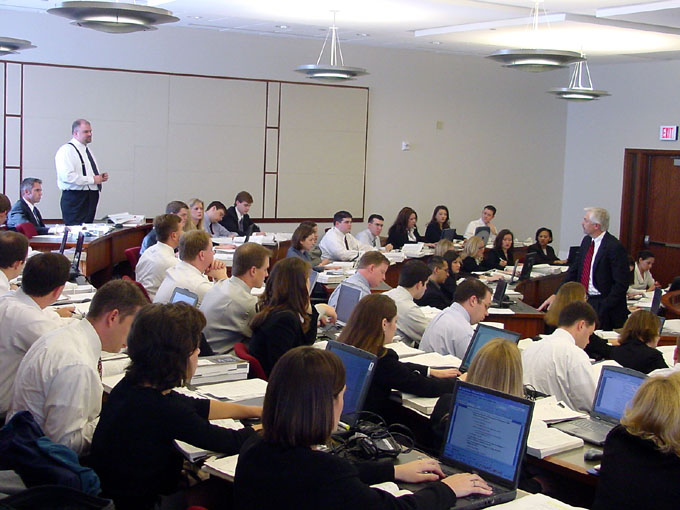Baylor Law School Applications Soar

Professor Bill Underwood calls on Raymond Dan Sorey during a Practice Court class at Baylor Law School. (Alan Hunt photo)
by Alan Hunt
Baylor Law School is THE place to be, according to the number of people who are clamoring to study law there. Overall applications for fall, spring and summer combined, increased 88.3 percent from 2001 to 2003, according to Dean Brad Toben.
"The applicant pool for the yet-to-be-matriculated fall 2003 class is above 2,085, which is the largest fall applicant pool ever and a 41-percent increase over 2002," Toben said. "The matriculation credentials of the fall 2003 class in all likelihood will exceed those of the fall 2002 class, which itself was record-breaking. For the fall 2002 class, we received 1,479 applications to fill the 82 seats in the class, an increase of 18.1 percent over fall 2001."
Toben said the credential level of Baylor's law students, which combines the Law School Admission Test (LSAT) with undergraduate grade-point-average, is in the top 15th-20th percentile range nationwide. "Within our student enrollment, about 82 percent of the students come from institutions other than Baylor, representing 115 degree-granting institutions. We have 46 percent women and a minority student enrollment of 14 percent."
Despite the popularity of Baylor Law School, the dean said the school's enrollment strategy is to reduce its class size. "For more than three decades, the target enrollment has been 400. We have occasionally 'swung' to either side of that target - we had 396 students in the fall 1999, 389 students in the fall 2000, 425 in fall 2001 and 438 in fall 2002. We even may have a very unanticipated 440 students or more in fall 2003, but only as a result of a burgeoning demand and the consequent unpredictable matriculation rate. While over-enrollment due to demand may appear to be a positive development, it is not healthy for the academic environment and is at odds with what we know is necessary to advance our school further in recognition."
Toben said he intends to vigorously pursue the Baylor 2012 objective to reduce the enrollment of the Law School over the next few years to a target of 375, rather than the current target of 400. "This lower enrollment level will both further enhance the learning environment benefits we now realize because of our small size and also will allow us to be very highly selective in our admissions,'" he pointed out.
Described recently by the "Princeton Review" as "the Marine Corps of law schools," Baylor Law School is ranked 51st in the nation by "U.S. News & World Report." The publication also rates Baylor's trial advocacy program 11th in the nation. In addition, the school continues to post an unmatched record of success on the Texas bar exam among law schools in Texas.
"Our faculty is committed to teaching our students to be lawyers and not to the teaching of law per se," Toben said. "We are proud of a faculty that is very actively engaged in scholarship that has truly benefited the practicing profession. Our path of distinctiveness has enabled us to break from a very large pack of law schools."